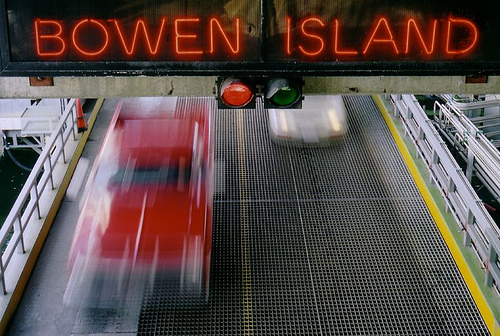|
|
Conceptual Model
|
Before any analysis occurred, a diagram indicating the needed information layers and the means by which the analysis would occur was prepared. The primary objective of finding areas on Bowen Island which would be most suitable for denser residential “cluster development” while adhering to the community goals outlined in the Official Community Plan, was broken down into four components: hazards, environmental sensitivity, compactness, and rural character. These four “sub analyses” were then combined hierarchically to produce a final suitability image.

CLICK TO EXPAND
The rational and objectives behind each of the sub analyses are as follows:
|
Constraints
|
Before developing the four components, a list of the completely undevelopable areas was prepared. This included:
Hydrological features-- streams, wetlands, and the ocean
Regulatory Restrictions—land in the Agricultural Land Reserve and Crown Land (which on Bowen has been retained for the purpose of conservation, making the transfer of ownership to the municipality or private owners unlikely).
Extremely Sensitive Ecosystems—because environmental factors are valued so highly by Bowen Islanders, forests over 120 years old (of which there are very few on Bowen) and areas identified as extremely sensitive ecosystems have been used as constraints.
Already developed—as the purpose of this analysis is to identify potential areas for residential growth and densification, areas which are already predominantly small lot and existing roads have been identified as constraints. For the purpose of this analysis “small lot” has been defined as lower than 5500 m2, which is still large in the urban context, but is quite small for Bowen. This size also encompasses most of the recent development on the island, and is characteristic of the majority of the lots on Bowen. Further subdivision of lots in this size bracket would likely be inconsistent with the character of the island. For these reasons we have considered these lots to be already developed, and therefore unsuitable for any further development.
|
Compactness
|
|
The ability to absorb the type of growth Bowen Island is expecting, which retaining the rural character and environmental assets of the island is going to depend on the compactness of the development which does occur. This objective, then, is interrelated with the other objectives identified in this analysis. To determine compactness, two measurements were combined: the distance from current roads, and the distance from existing dwellings.
The objective of compactness is consistent with OCP level goals, and as rural planner Randal Arendt has noted in “Rural by Design,” compactness is essential for maintaining service efficiency, and a high level of natural amenity.
|
Hazards
|
|
The ability to absorb the type of growth Bowen Island is expecting, while retaining the rural character and environmental assets of the island is going to depend on the compactness of the development which does occur. This objective, then, is interrelated with the other objectives identified in this analysis. To determine compactness, two measurements were combined: the distance from current roads, and the distance from existing dwellings.
The objective of compactness is consistent with OCP level goals, and as rural planner Randal Arendt has noted in “Rural by Design,” compactness is essential for maintaining service efficiency, and a high level of natural amenity.
|
Environmental Sensitivity
|
A number of studies were conducted on Bowen Island in the late 1970s identifying ecologically sensitive areas containing rare plants and significant examples of rare ecosystems. A number areas were also identified which, if developed, could negatively effect water quality by introduction of impervious surfaces and septic fields. Bowen Island residents have clearly indicated their desire to preserve these areas, and as such they were a significant factor in the analysis. In addition the following factors were aggregated:
Distance from streams
Distance from wetlands
Distance from springs
Forest age
|
Rural Character
|
Though the preservation of the Island’s “rural character” is intangible and difficult to measure with a GIS, it was necessary to find some proxy means of including it in the analysis, because it is so important to the Island’s residents. Two factors were identified which pertain to rural character: agricultural land and visibility from the shoreline. The preservation of existing farmland is essential to the preservation of “rural character”. Randal Arendt has shown that if development occurs in a rural area, but farmland is maintained along long stretches of road, the character of the area is not compromised.
Visibility from the shore was included because it provides a means of reducing the visual impact of new development, allowing planners to identify areas which will not compromise the natural character of the island as seen from afar.
|
|
|

